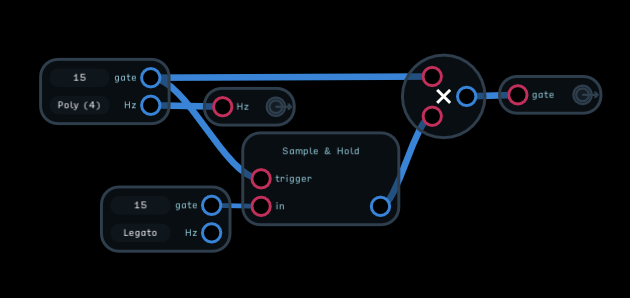I didn’t realize that. I think @futureaztec is losing his velocity signal because of the expression.
Let me know if you think of a way around it. I am happy I at least got mostly everything else sorted.
I was looking at your patch and noticed that you have the Poly keyboard with velocity module configured incorrectly. The lower keyboard node should be set to legato, not poly(4). The lower keyboard node provides the velocity signal.

I was playing around with your patch and discovered that the maximum velocity signal from the keyboard node is actually somewhat less than 1 (0.992 at MIDI velocity 127) so removing the x>0 expression would actually make the output gate a bit lower even at velocity 127. For some reason I mistakenly thought that the gate would exceed 1 at higher MIDI velocities.
If I set the lower node to legato the drum no longer responds and the velocity values peak at about 40%. When set to Poly, drum rolls work just fine. However, velocity values have always seemed to be stuck in the range of about 80-127. It would be nice to be able to play softer as well, but 80-127 is a more useful range than, say, 1-40.
If you set the lower node to poly, you will no longer have a gate that varies with velocity. You might as well just use the standard keyboard node and eliminate the S&H. If the velocity value is too low you might scale it up.
The scaling is a good idea. When I say that “if I set the lower node to legato the drum no longer responds,” here is what happens: I have two voices hooked up in two of the four regions on the boppad, a snare and a ride. The ride will sound one strike then nothing. The snare won’t sound at all. Still, it looks like velocity values (though scaled down quite a bit) are registering.
It depends on what velocity values the Bobpad is sending. I did some testing this morning and a velocity value of 127, which is the maximum, produces 0.992 as the gate output. A value of 64 produces a 0.5 gate and a 32 produces 0.25. It looks like Audulus scales the gate by dividing the velocity by 128. I played with the snare module in your patch and it produces almost no output if the gate is much lower than 1. The ride module is a bit more sensitive but it also really needs a gate at 1 or above. Try scaling the BopPad’s velocity signal up so the the end result is a bit over 1
Following your lead, I hooked up a value node to the gate output of the midi module in question.
If I jam my fist into the boppad I can get 127 (reminds me of hitting the scale with a mallet at the carnival). The unit has a nice editor, so I could do the scaling there probably, but I would like to be able to do the adjustments further down the line if possible. What is the best way to do the scaling in Audulus? Would you use an expression instead of an attenuator, since any increase in the lower numbers would leave them at a high resting value? I wonder if it is a matter of having an exponential rise…
I would try a simple multiply first. You could certainly experiment with other curves if the multiply isn’t satisfactory. It also depends on the module you’re driving. The snare module you’re using goes from almost nothing to a reasonable volume over a pretty short range whereas the ride has a bit more flexible response. The uConga module I put together doesn’t really change output volume regardless of gate height. Depending on how the module is put together internally, many of the percussive effects don’t vary their output with gate height. You might need to customize some percussion modules to really get good response from the velocity signal from the BopPad. Here’s a modified uConga which uses the gate height to vary the output volume. You could also use the gate height to modify other parameters so the sound would change timbre as well as volume. Use a S&H node to grab the gate height then you can use the value.
modified uConga with velocity.audulus (46.1 KB)